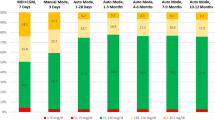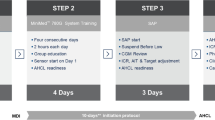Abstract
Purpose
In recent years there has been a noticeable increase in the use of advanced hybrid closed-loop systems (AHCLs) for managing type 1 diabetes (T1D) among youth. However, there is a lack of comparison between the open-source automated insulin delivery (AID) system and the MiniMed™ 780 G system (780 G).
Methods
In this multi-center study, we retrospectively compared selected glycemic ranges of 26 individuals who used open-source AID and 20 individuals who used 780 G (age 11.3 years [IQR 9.3, 12.9] and 13.4 years [IQR 10.9, 16.5], respectively, p = 0.069) from system initiation to the most recent visit.
Results
At baseline, the median HbA1c was significantly lower and the time below range (TBR)<54mg/dL was significantly higher in the open-source AID group compared to the 780 G group (6.8% [IQR 6.4, 7.1] vs. 7.4% [IQR 6.9, 8.6], p = 0.006 and (1.0% [IQR 0.5, 2.8] vs. 0.0% [0.0, 1.0], p = 0.014), respectively; the median time in range (TIR70–180mg/dL) was similar (p = 0.068). After a median duration of 10.9 months on AHCLs the reduction of HbA1c was similar ( ~ 0.3%). The time spent in the hypoglycemic ranges was longer among users of the open-source AID compared to 780 G (TBR54–70mg/dL 4.2% [IQR 2.6, 7.3] vs. 2.0% [1.0, 4.0], p = 0.005) and TBR<54mg/dL 1.1% [IQR 0.4, 2.3] vs. 0.0 [0.0, 1.0], p = 0.001).
Conclusions
Both AHCLs similarly improved HbA1c and TIR70–180mg/dL. The open-source AID youth had better glycemic control but spent longer time in the hypoglycemic range. These findings must be considered when choosing the use of AHCL technologies.

Similar content being viewed by others
References
R.A. Lal, L. Ekhlaspour, K. Hood, B. Buckingham, Realizing a closed-loop (Artificial Pancreas) system for the treatment of Type 1 diabetes. Endocr. Rev. 40, 1521–1546 (2019)
K. Braune, R.A. Lal, L. Petruželková, G. Scheiner, P. Winterdijk, S. Schmidt, L. Raimond, K.K. Hood, M.C. Riddell, T.C. Skinner, K. Raile, S. Hussain, Open-source automated insulin delivery: international consensus statement and practical guidance for health-care professionals. Lancet Diabetes Endocrinol. 10, 58–74 (2022)
J.L. Sherr, L. Heinemann, G.A. Fleming, R.M. Bergenstal, D. Bruttomesso, H. Hanaire, R.W. Holl, J.R. Petrie, A.L. Peters, M. Evans, Automated insulin delivery: benefits, challenges, and recommendations. A consensus report of the joint diabetes technology working group of the european association for the study of diabetes and the American Diabetes Association. Diabetologia 66, 3–22 (2023)
L. Petruzelkova, P. Jiranova, J. Soupal, M. Kozak, L. Plachy, V. Neuman, S. Pruhova, B. Obermannova, S. Kolouskova, Z. Sumnik, Pre-school and school-aged children benefit from the switch from a sensor-augmented pump to an AndroidAPS hybrid closed loop: A retrospective analysis. Pediatr. Diabetes 22, 594–604 (2021)
M.J. Burnside, D.M. Lewis, H.R. Crocket, R.A. Meier, J.A. Williman, O.J. Sanders, C.A. Jefferies, A.M. Faherty, R.G. Paul, C.S. Lever, S.K.J. Price, C.M. Frewen, S.D. Jones, T.C. Gunn, C. Lampey, B.J. Wheeler, M.I. de Bock, Open-source automated insulin delivery in Type 1 diabetes. N. Engl. J. Med. 387, 869–881 (2022). https://doi.org/10.1056/NEJMoa2203913
J. Da Silva, G. Lepore, T. Battelino, A. Arrieta, J. Castañeda, B. Grossman, J. Shin, O. Cohen, Real-world performance of the MiniMed™ 780G system: first report of outcomes from 4120 users. Diabetes Technol. Ther. 24, 113–119 (2022)
M. Bassi, M. Teliti, M. Lezzi, A. Iosca, M.F. Strati, L. Carmisciano, G. d’Annunzio, N. Minuto, D. Maggi, A Comparison of Two Hybrid Closed-Loop Systems in Italian Children and Adults With Type 1 Diabetes. Front Endocrinol. (Lausanne) 12, 802419 (2022)
Characterization and Classification of Statistical Areas Within Municipalities and Local Councils by the Socio-Economic Level of the Population 2015. 2019
T. Battelino, T. Danne, R.M. Bergenstal, S.A. Amiel, R. Beck, T. Biester, E. Bosi, B.A. Buckingham, W.T. Cefalu, K.L. Close, C. Cobelli, E. Dassau, J.H. DeVries, K.C. Donaghue, K. Dovc, F.J. Doyle, S. Garg, G. Grunberger, S. Heller, L. Heinemann, I.B. Hirsch, R. Hovorka, W. Jia, O. Kordonouri, B. Kovatchev, A. Kowalski, L. Laffel, B. Levine, A. Mayorov, C. Mathieu, H.R. Murphy, R. Nimri, K. Nørgaard, C.G. Parkin, E. Renard, D. Rodbard, B. Saboo, D. Schatz, K. Stoner, T. Urakami, S.A. Weinzimer, M. Phillip, Clinical targets for continuous glucose monitoring data interpretation: recommendations from the international consensus on time in range. Diabetes Care 42, 1593–1603 (2019)
R.M. Bergenstal, R.W. Beck, K.L. Close, G. Grunberger, D.B. Sacks, A. Kowalski, A.S. Brown, L. Heinemann, G. Aleppo, D.B. Ryan, T.D. Riddlesworth, W.T. Cefalu, Glucose management indicator (GMI): a new term for estimating a1c from continuous glucose monitoring. Diabetes Care 41, 2275–2280 (2018)
K. Braune, S. O’Donnell, B. Cleal, D. Lewis, A. Tappe, I. Willaing, B. Hauck, K. Raile, Real-world use of do-it-yourself artificial pancreas systems in children and adolescents With Type 1 diabetes: online survey and analysis of self-reported clinical outcomes. JMIR Mhealth Uhealth 7, 14087 (2019)
K. Braune, K.A. Gajewska, A. Thieffry, D.M. Lewis, T. Froment, S. O’Donnell, J. Speight, C. Hendrieckx, J. Schipp, T. Skinner, H. Langstrup, A. Tappe, K. Raile, and B. Cleal, Why #WeAreNotWaiting-Motivations and Self-Reported Outcomes Among Users of Open-source Automated Insulin Delivery Systems: Multinational Survey. J Med Internet Res 23, https://doi.org/10.2196/25409 (2021)
A. Arrieta, T. Battelino, A.E. Scaramuzza, J. Da Silva, J. Castañeda, T.L. Cordero, J. Shin, O. Cohen, Comparison of MiniMed 780G system performance in users aged younger and older than 15 years: evidence from 12 870 real-world users. Diabetes Obes. Metab. 24, 1370–1379 (2022)
K. Dovc, T. Battelino, Time in range centered diabetes care. Clin. Pediatr. Endocrinol. 30, 1–10 (2021)
T. Urakami, Severe hypoglycemia: is it still a threat for children and adolescents with Type 1 diabetes? Front Endocrinol. (Lausanne) 11, 609 (2020)
L. Zhang, L. Yang, Z. Zhou, Data-based modeling for hypoglycemia prediction: Importance, trends, and implications for clinical practice. Front Public Health 11, (2023)
Acknowledgements
The authors thank Esther Eshkol for editorial assistance.
Funding
This research did not receive any specific grant from funding agencies in the public, commercial, or not-for-profit sectors.
Author information
Authors and Affiliations
Contributions
Conception and design: Z.L., Y.L., M.R., O.P.H.; Curation of data: Z.L., Y.L., K.M.A., A.B., N.L., T.J.P., T.B.A., S.A., A.H., J.N., M.R., O.P.H.; Analysis of data: Z.L., O.P.H.; drafting the article: Z.L., Y.L., O.P.H.; revising it critically: Z.L., Y.L., K.M.A., A.B., N.L., T.J.P., T.B.A., S.A., A.H., J.N., M.R., O.P.H.; final approval of the version to be submitted: Z.L., Y.L., K.M.A., A.B., N.L., T.J.P., T.B.A., S.A., A.H., J.N., M.R., O.P.H.
Corresponding authors
Ethics declarations
Conflict of interest
The authors declare no competing interests.
Ethics approval
The research adheres to the principles outlined in the Declaration of Helsinki. The study received ethical approval from the local Helsinki committees of each participating medical center. Informed consent was waived for this retrospective investigation.
Additional information
Publisher’s note Springer Nature remains neutral with regard to jurisdictional claims in published maps and institutional affiliations.
Rights and permissions
Springer Nature or its licensor (e.g. a society or other partner) holds exclusive rights to this article under a publishing agreement with the author(s) or other rightsholder(s); author self-archiving of the accepted manuscript version of this article is solely governed by the terms of such publishing agreement and applicable law.
About this article
Cite this article
Landau, Z., Lebenthal, Y., Mazor-Aronovitch, K. et al. A comparison of the usage of an open-source automated insulin delivery system and the MiniMed™ 780 G system in children and adolescents with type 1 diabetes in real-world settings: the AWeSoMe study group. Endocrine (2024). https://doi.org/10.1007/s12020-024-03683-w
Received:
Accepted:
Published:
DOI: https://doi.org/10.1007/s12020-024-03683-w




